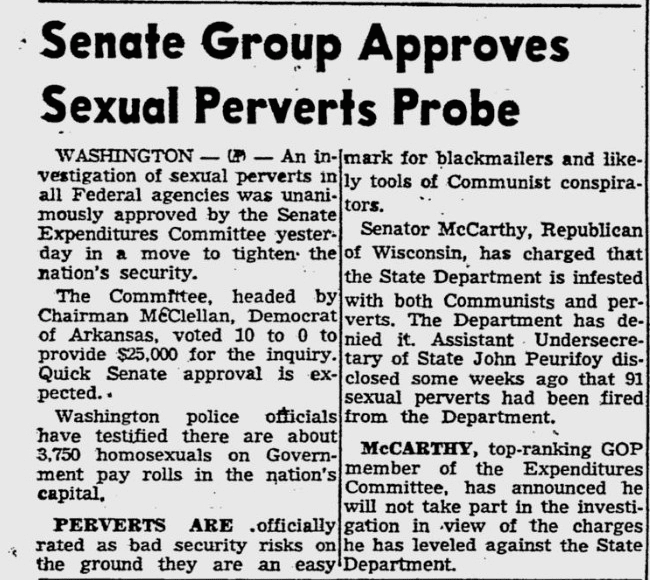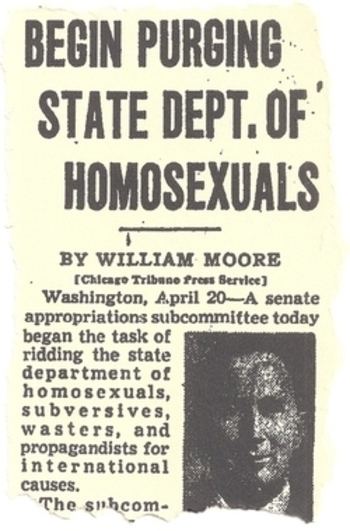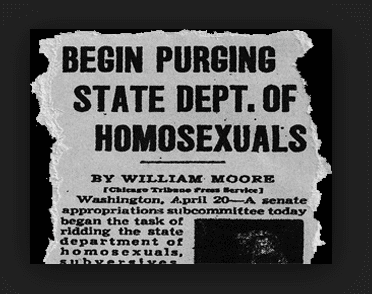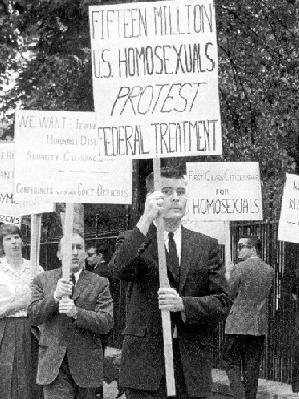 | ||
The lavender scare refers to a witch hunt and mass firings of gay people in the 1950s from the United States government. It paralleled the anti-communist campaign known as McCarthyism and the Second Red Scare. Gay men and lesbians were said to be security risks and communist sympathizers, which led to the call to remove them from state employment.
Contents
- Etymology
- History
- Executive Order 10450
- Association of communism with subversives
- Subcommittee on Investigations
- Contemporary views of homosexuality
- Resistance
- Legacy
- Documentary
- References

Former U.S. Senator Alan K. Simpson has written: "The so-called 'Red Scare' has been the main focus of most historians of that period of time. A lesser-known element ... and one that harmed far more people was the witch-hunt McCarthy and others conducted against homosexuals."
Etymology

The term for this persecution was popularized by David K. Johnson's 2004 book which studied this anti-homosexual campaign, The Lavender Scare. The book drew its title from the term "lavender lads", used repeatedly by Senator Everett Dirksen as a synonym for homosexual males. In 1952, Dirksen said that a Republican victory in the November elections would mean the removal of "the lavender lads" from the State Department. The phrase was also used by Confidential magazine, a periodical known for gossiping about the sexuality of politicians and prominent Hollywood stars.
History
In 1950, the same year that Senator Joseph McCarthy claimed 205 communists were working in the State Department, Undersecretary of State John Peurifoy said that the State Department had allowed 91 homosexuals to resign. On April 19, 1950, the Republican National Chairman Guy George Gabrielson said that "sexual perverts who have infiltrated our Government in recent years" were "perhaps as dangerous as the actual Communists". The danger was not solely because they were gay though. The homosexuals were considered to be more susceptible to blackmail and thus were labeled as security risks. McCarthy hired Roy Cohn—who died of AIDS and was accused of being a closeted homosexual—as chief counsel of his Congressional subcommittee. Together, McCarthy and Cohn—with the enthusiastic support of the head of the FBI, J. Edgar Hoover were responsible for the firing of scores of gay men and women from government employment and strong-armed many opponents into silence using rumors of their homosexuality. In 1953, during the final months of the Truman administration, the State Department reported that it had fired 425 employees for allegations of homosexuality.

McCarthy often used accusations of homosexuality as a smear tactic in his anti-communist crusade, often combining the Second Red Scare with the Lavender Scare. On one occasion, he went so far as to announce to reporters, "If you want to be against McCarthy, boys, you've got to be either a Communist or a cocksucker." Some historians have argued that, in linking communism and homosexuality and psychological imbalance, McCarthy was employing guilt-by-association if evidence for communist activity was lacking.
Executive Order 10450
In 1953 President Dwight D. Eisenhower signed Executive Order 10450. EO10450 set security standards for federal employment and barred homosexuals from working in the federal government. The restrictions set in place were cause for hundreds of homosexuals to be exposed as gay and fired from the state department. The EO was also the cause for the firing of approximately 5,000 homosexuals from federal employment; this included private contractors and military personnel. Not only did the victims lose their jobs, but also they were forced out of the closet and thrust into the public eye as homosexuals. The EO stayed on paper and in effect until 1995 when President Bill Clinton rescinded the order and put in place the "Don't ask, don't tell" policy for admittance of gays into the military.
Association of communism with "subversives"

Both homosexuals and communist party members were seen as subversive elements in American society who all shared the same ideals of antitheism, rejection of bourgeois culture and middle-class morality, lack of conformity; they were scheming and manipulative and, most importantly, would put their own agendas above others in the eyes of the general population. McCarthy also associated homosexuality and communism as "threats to the 'American way of life'." Homosexuality was directly linked to security concerns, and more government employees were dismissed because of their homosexual sexual orientation than because they were left-leaning or communist. George Chauncey noted that, "The specter of the invisible homosexual, like that of the invisible communist, haunted Cold War America," and homosexuality (and by implication homosexuals themselves) were constantly referred to not only as a disease, but also as an invasion, like the perceived danger of communism and subversives.
Senator Kenneth Wherry similarly attempted to invoke a connection between homosexuality and anti-nationalism. He said in an interview with Max Lerner that "You can't hardly separate homosexuals from subversives." Later in that same interview, he drew the line between patriotic Americans and gay men: "But look Lerner, we're both Americans, aren't we? I say, let's get these fellows [closeted gay men in government positions] out of the government."
Connections between gay rights groups and so-called subversive elements were not entirely baseless. The Mattachine Society, one of the earliest gay rights groups in the United States, was founded by Harry Hay, a former member of the Communist Party USA, who resigned when the membership condemned his politics as a threat to the organization he had founded.
Subcommittee on Investigations
The Subcommittee on Investigations was a subcommittee of the Committee on Expenditures in Executive Departments. This subcommittee led by Senator Clyde R. Hoey from 1949-1952 investigated "the employment of homosexuals in the Federal workforce." A related report, known as the Hoey Report, stated that all of the government's intelligence agencies "are in complete agreement that sex perverts in Government constitute security risks."
Contemporary views of homosexuality
Washington D.C. had a fairly large and active gay community before McCarthy launched his witch hunt campaign against homosexuals, but as time went on and the climate of the Cold War spread, so too did the negative views of homosexuals. Because social attitudes toward homosexuality were overwhelmingly negative and the psychiatric community regarded homosexuality as a mental disorder, gay men and lesbians were considered susceptible to blackmail, thus constituting a security risk. U.S. government officials assumed that communists would blackmail homosexual employees of the federal government to provide them classified information rather than risk exposure. The 1957 Crittenden Report of the United States Navy Board of Inquiry concluded that there was "no sound basis for the belief that homosexuals posed a security risk" and criticized the prior Hoey Report: "No intelligence agency, as far as can be learned, adduced any factual data before that committee with which to support these opinions" and said that "the concept that homosexuals necessarily pose a security risk is unsupported by adequate factual data." The Crittenden Report remained secret until 1976. Navy officials claimed they had no record of studies of homosexuality, but attorneys learned of its existence and obtained it through a Freedom of Information Act request. As of September 1981, the Navy claimed it was still unable to fulfill a request for the Report's supporting documentation.
According to John Loughery, author of a study of gay identity in the 20th century, "few events indicate how psychologically wracked America was becoming in the 1950s ... than the presumed overlap of the Communist and the homosexual menace."
The research of Evelyn Hooker, presented in 1956, and the first conducted without a polluted sample (gay men who had been treated for mental illness) dispelled the illusory correlation between homosexuality and mental illness that prior research, conducted with polluted sampling, had established. Hooker presented a team of three expert evaluators with 60 unmarked psychological profiles from her year of research. She chose to leave the interpretation of her results to others, to avoid potential bias. The evaluators concluded that in terms of adjustment, there were no differences between the members of each group. Her demonstration that it is not an illness led the way to the eventual removal of homosexuality from the American Psychiatric Association's Diagnostic and Statistical Manual of Mental Disorders.
Resistance
One of the first and most influential members of the gay rights movements, Frank Kameny, was thrust into unemployment because of his sexual orientation in 1957. He was working as an astronomer for the United States Army Map Service, but was fired as a result of the Lavender Scare and could never find another job in the United States federal government again. This led to Kameny devoting his life to the gay rights movement, which in some ways he began. In 1965, 4 years before the Stonewall Riots, Kameny picketed the White House on the grounds of gay rights.
According to Lillian Faderman, the LGBT community formed a subculture of its own in this era, constituting "not only a choice of sexual orientation, but of social orientation as well." The Mattachine Society and the Daughters of Bilitis, which formed the homophile movements of the U.S., were in many ways defined by McCarthyism and the lavender scare. They were underground organizations that maintained the anonymity of their members.
Legacy
Though the main vein of McCarthyism ended in the mid-1950s when the 1956 Cole v Young ruling severely weakened the ability to fire people from the federal government for discriminatory reasons, the movement that was born from it, the Lavender Scare, lived on. One such way was that Executive Order 10450, which was not rescinded until 1995, continued to bar gays from entering the military. Another form of the Lavender Scare that persisted was the Florida Legislative Investigation Committee, also referred to as the FLIC and the Johns Committee. The FLIC was founded in 1956 and was not disbanded until 1964. The purpose of the committee was to operate within Florida continuing the work of the Lavender Scare by investigating and firing public school teachers that were gay. During its active years the FLIC was responsible for more than 200 firings of alleged gay teachers. The FLIC was disbanded following the release of the Purple Pamphlet due to public outrage over its explicit and pornographic nature.
In January 2017, the State Department formally apologized.
Documentary
The Lavender Scare, directed by Josh Howard, was a documentary planned to recount the events of the Lavender Scare. David K. Johnson was part of the project as the movie was based on his book. The original release was set for 2013 but was postponed. To help with funding, Josh Howard created a Kickstarter that met its goal in donations. The last update to the Kickstarter page was in October 2014. It stated that the movie was finally moving into post production, but an official release date was never announced.
